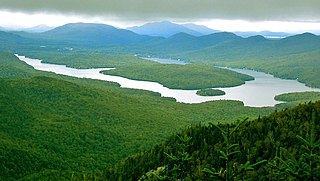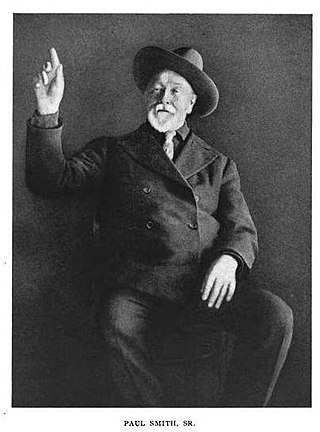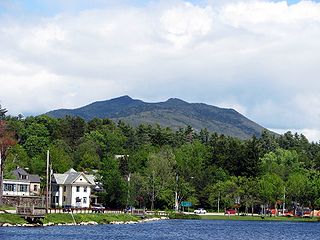Related Research Articles

Essex County is a county in the U.S. state of New York. As of the 2020 census, the population was 37,381. Its county seat is the hamlet of Elizabethtown. Its name is from the English county of Essex. Essex is one of only 2 counties that are entirely within the Adirondack Park, the other being Hamilton County.

The Adirondack Mountains are a massif of mountains in Northeastern New York which form a circular dome approximately 160 miles (260 km) wide and covering about 5,000 square miles (13,000 km2). The region contains more than 100 peaks, including Mount Marcy, which is the highest point in New York at 5,344 feet (1,629 m). The Adirondack High Peaks, a traditional list of 46 peaks over 4,000 feet (1,200 m), are popular hiking destinations. There are over 200 named lakes with the number of smaller lakes, ponds, and other bodies of water reaching over 3,000. Among the named lakes around the mountains are Lake George, Lake Placid, and Lake Tear of the Clouds. The region has over 1,200 miles (1,900 km) of river.

Keene is a town in central Essex County, New York, United States. It includes the hamlets of Keene, Keene Valley, and St. Huberts, with a total population of 1,144 as of the 2020 census

North Elba is a town in Essex County, New York, United States. The population was 7,480 at the 2020 census.

Franklin is a town located in Franklin County, New York, United States. As of the 2010 census, the town had a population of 1,140.

The Adirondack Park is a part of New York's Forest Preserve in northeastern New York, United States. The park was established in 1892 for "the free use of all the people for their health and pleasure", and for watershed protection. The park's boundary roughly corresponds with the Adirondack Mountains. Unlike most state parks, about 52 percent of the land is privately owned inholdings. State lands within the park are known as Forest Preserve. Land use on public and private lands in the park is regulated by the Adirondack Park Agency. This area contains 102 towns and villages, as well as numerous farms, businesses and an active timber-harvesting industry. The year-round population is 132,000, with 200,000 seasonal residents. The inclusion of human communities makes the park one of the great experiments in conservation in the industrialized world. The Forest Preserve was designated a National Historic Landmark in 1963.
The Adirondack High Peaks are a set of 46 mountain peaks in the Adirondack Mountains of New York state. They have been popular hiking destinations since the late 1920s, when the list of peaks was published in Russell Carson's book Peaks and Peoples of the Adirondacks. Those who have climbed all 46 High Peaks are eligible to join the Adirondack Forty-Sixers club.

The Adirondak Loj is a historic lodge in North Elba, Essex County, New York. It is near Lake Placid in the Adirondack Mountains. The current facility, located on the shore of Heart Lake, was built in 1927 and is owned and operated by ADK. The Loj property hosts the trailhead of the popular Van Hoevenberg Trail, which leads to Mount Marcy and Algonquin Peak, the two highest points in the state.

The Adirondack Mountain Club (ADK) is a nonprofit organization founded in 1922. It has approximately 30,000 members. The ADK is dedicated to the protection and responsible recreational use of the New York State Forest Preserve, parks, wild lands, and waters; it conducts conservation, and natural history programs. There are 27 local chapters in New York and New Jersey. The club has worked to increase state holdings in the Adirondack Park and to protect the area from commercial development.

Tupper Lake is a village in Franklin County, New York, United States. The population was 3,282 at the 2020 census. The village is located within the boundaries of the Adirondack Park, west of Lake Placid. Along with nearby Saranac Lake, these three villages make up what is known as the Tri-Lakes region.

Northwood School is an independent co-educational boarding and day school for grades 9 through 12 located in Lake Placid, New York in the heart of the Adirondack Mountains.
The Giant Mountain Wilderness Area, an Adirondack Park unit of New York's Forest Preserve, lies in Essex County, New York, in the towns of Elizabethtown and Keene. It is roughly bounded by NY 9N on the north, NY 73 on the west and south and US 9 on the east. It includes two bodies of water covering 5 acres, 12.5 miles (20.1 km) of trails, and a single lean-to.
The High Peaks Wilderness Area, the largest Forest Preserve unit in the U.S. state of New York, is located in three counties and six towns in the Adirondack Park: Harrietstown in Franklin County, North Elba, Keene, North Hudson and Newcomb in Essex County and Long Lake in Hamilton County.
The Northville–Lake Placid Trail, also known as the NPT, is a lightly travelled foot trail that runs 138 miles (214 km) through the Adirondack Park in northern New York State. It was laid out by the Adirondack Mountain Club in 1922 and 1923 and is maintained by the New York State Department of Environmental Conservation. From 2014-2016 the southern section of the trail was re-routed to remove most of the road walk into the town of Northville. The southern terminus is Waterfront Park in Northville, NY and the northern terminus is Averyville Rd in Lake Placid.

Apollos "Paul" Smith (1825–1912) was an American hunting and fishing guide from Vermont who founded the Saint Regis House in the Town of Brighton, New York, in the Adirondack Mountains. It was known universally as Paul Smith's Hotel, one of the first wilderness resorts in the Adirondacks. In its day, it was the most fashionable of the many great Adirondack hotels, patronized by American presidents, celebrities, and the power elite of the latter half of the 19th century. It was a large operation, with 255 rooms, stables, and many other amenities.

McKenzie Mountain is a 3,861-foot (1,177 m) mountain in western Essex County in the towns of St. Armand and North Elba in the Adirondack Park, a unit of the Forest Preserve.
The New York State College of Forestry at Cornell was a statutory college established in 1898 at Cornell University to teach scientific forestry. The first four-year college of forestry in the country, it was defunded by the State of New York in 1903, over controversies involving the college's forestry practices in the Adirondacks. Forestry studies continued at Cornell even after the college's closing.

Loon Lake is a hamlet and a lake in the northeastern region of Adirondack Park in the U.S. state of New York. The community is located on the east side of Loon Lake and 18 miles (29 km) northeast of Saranac Lake and 27 miles (43 km) north of Lake Placid.

Placid Lake State Park is a public recreation area located 28 miles (45 km) northeast of Missoula, Montana. The state park sits on 31 acres (13 ha) at the eastern end of Placid Lake that include the lake's outlet to Owl Creek, a tributary of the Clearwater River. The park is known for its scenery, camping, aquatic recreation, and fishing.

Timbuctoo, New York, was a mid-19th century farming community of African-American homesteaders in the remote town of North Elba, New York. It was located in the vicinity of 44.22°N 73.99°W, near today's Lake Placid village, in the Adirondack Mountains of Upstate New York. Contrary to the information given out by donor Gerrit Smith, who said that the lots were in clusters, they were spread out over an area 40 miles (64 km) north to south, and 15 miles (24 km) east to west.
References
- 1 2 David A. Paterson & Alexander B. Grannis. "Fire Tower Study for the Adirondack Park." NY State Department of Environmental Conservation. Retrieved 2020-04-24.
- 1 2 3 4 5 6 7 8 Suter, Herman Milton; United States. Bureau of Forestry (1904). Forest fires in the Adirondacks in 1903. National Agricultural Library U. S. Department of Agriculture. [Washington, Govt. Print. Off.]
- 1 2 "Adirondack Forest Succession". wildadirondacks.org. Retrieved 2020-04-25.
- 1 2 Unknown (2016-04-26). "ADK Forever Wild: Forest Fires in the Adirondacks". ADK Forever Wild. Retrieved 2020-04-25.
- 1 2 3 4 5 6 7 "Adirondack Forest Fires | Adirondack Experience: More than a Museum". Adirondack Experience. 4 April 2017. Retrieved 2020-04-25.
- 1 2 3 4 "1908: Forest fires wipe out Adirondack village (photos)". newyorkupstate. 2018-09-29. Retrieved 2020-04-25.
- 1 2 3 4 5 "Adirondack Life Article - The Big Burn - Adirondack Life". www.adirondacklifemag.com. Retrieved 2020-04-25.
- ↑ "The Johnstown daily Republican. volume (Johnstown, N.Y.) 1890-1912, May 20, 1903, Image 1" (1903/05/20). 1903-05-20: 1.
{{cite journal}}: Cite journal requires|journal=(help) - 1 2 3 "Ithaca daily journal. (Ithaca, N.Y.) 1872-1913, May 01, 1903, Image 8" (1903/05/01). 1903-05-01: 8.
{{cite journal}}: Cite journal requires|journal=(help) - ↑ "Fire towers get second life a century on | News, Sports, Jobs - Adirondack Daily Enterprise" . Retrieved 2020-04-25.
- ↑ Erin R. Abadir, et al. "Historical Fire Regimes in Red Pine Forests of the Adirondack Mountains, New York, USA." Natural Areas Journal. Retrieved 2020-04-24.